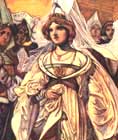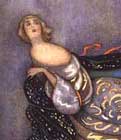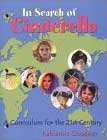
Cinderella:
345 Variants
by Marian
Roalfe Cox
SurLaLune's
Cinderella Area
SurLaLune Fairy Tales Main Page
50
Von Hahn, Griechische und Albanesische Märchen. Gesammelt, ubersetzt und erlautert von J. G. von Hahn. Leipzig, 1864. Vol. i, p. 70. Story No. II.
"ASCHENPUTTEL."
ABSTRACT
Spinning by mother and three daughters for wager. First who drops spindle to be eaten by others--Elder sisters kill and eat mother--Weeping heroine sits on dirty saddle under henroost-- Collects bones; buries them near hearth--Ill-treated heroine (by sisters)--Grave help--Bones transformed to coins and Magic dresses --Meeting-place (church) -- Threefold flight-- Heroine scatters coins to detain pursuers--Lost Shoe--Shoe marriage test--Happy marriage--Heroine, after birth of child, put into chest by sisters and flung into river--Imbecile woman finds and opens chest; runs away from heroine--Magical castle obtained by prayers, removable at will --Spoons and forks, etc., come, and table spreads itself at command--Speaking furniture, etc.-- Hunting prince comes to castle. Spoon stolen by him leads to explanations and recognition of heroine. Villain Nemesis.
TABULATION
(1) Three sisters spinning with their mother agree that the first one who breaks her thread and drops her spindle shall be eaten by the others.1-- (2) The mother drops her spindle thrice; she is twice forgiven, but the third time the two elder sisters determine to enforce the agreement. They kill and eat the mother, in spite of the prayers and tears of the youngest, who refuses to join them at the table or to taste her mother's flesh.-- (3) She sits on a wooden saddle which stands under the hen-roost, and becomes covered with the droppings of the fowls, and she weeps and curses her sisters. They call her Fowlsdungskin in derision.-- (4) When they have finished, the heroine collects her mother's bones and other remains, and buries them2 by the ash-heap, and every day she fumigates them with incense. After the forty days are over she desires to remove them to another place; but when she lifts the stone under which they lie, instead of the bones she finds three costly shining dresses. On one is embroidered the heaven with its stars, on another the spring with its flowers, on the third the sea with its waves; and with them lies a great heap of all sorts of money.-- (5) The next Sunday, after the elder sisters have gone to church, the heroine washes, and puts on the first of these three dresses, fills her pockets with money, and goes to church. Everyone is dazzled, and after the service many follow her out of curiosity; but she escapes by scattering money. When her sisters return they tell her of the beautiful lady who had been at church, and show the money they have picked up, telling her that if she had gone she would have had a share. She feigns indifference.-- (6) The next Sunday the adventure is repeated.-- (7) The third Sunday she is followed by the king's son, and in running away she loses her slipper. While the king's son picks it up she escapes.-- (8) The king's son makes known that he will marry the woman whose foot the slipper will fit, he goes from house to house seeking her. The heroine's sisters advise her to try the slipper on, as her foot is so small it will be sure to fit. With great difficulty she is persuaded to try, when the king's son comes to the house; and he marries her.-- (9) When she gives birth to a child her sisters attend her. They have become envious, and shut her up in a chest and throw her into the river. [Nothing is said about the babe.] The chest floats and comes to land, where it is found by an imbecile old woman, who takes it for firewood. When she cleaves it with her axe the heroine springs out, which so frightens the old woman that she runs away and never comes back.-- (10) The heroine, left alone, prays to God for a cover for her head, that she may not hear the cries of the wild beasts which disturb her. God gives her the covering; she prays that it may be enlarged so as to envelope half her body. Finding this prayer too is granted, she prays for a great castle with every convenience. Scarcely has she finished her prayer when she finds herself in a magnificent castle where all the furniture can hear her commands and perform them, and answer her when she speaks.-- (11) One day the king's son comes that way hunting. Seeing the castle, he knocks at the door, and the door opens by the heroine's command. Sitting on a throne, she welcomes him, and all the things in the castle, in response to her, bid him welcome. He does not recognise her. She bids the table be laid, and they sit down to eat.-- (12) The king's son steals a spoon.3 When they have finished their meal she asks, "Table, hast thou all thy linen?" The table answers "Yes". She then asks, "Spoons, are you all there?" They answer, "Yes, save one"; and that one answers, "I am stuck in the guest's boot." Feigning not to hear, she asks again, and the prince, turning very red, throws the spoon secretly away. The heroine says, "Why do you blush? I see very well what you have done; but you need not fear, for I am your wife; and thus and thus has it happened to me." She tells him all, and commands the castle to remove to the capital. The whole castle moves accordingly. Full of joy, the people come out to meet it. The prince sends for his two sisters-in-law; with his own hand he hews them in pieces, and lives with his wife happy ever after.
NOTES
Note 35
(P. 244.) Girls eat their mother in Nos. 50, 53, 124; girls eat their sisters in Nos. 17, 278. For other examples of cannibalism in folk-tales, see American F.-L. Journal, ii, 54, "Legends of the Cherokees"; Asbjornsen og Moe, Nos. 1, 52; Athanas'ev, i, 121; Callaway, Z. F. T., notes, p. 158 et seq. Campbell, iii, 297; Dasent, pp. 71, 128, 220; Day, Folk-tales of Bengal, pp. 72, 79, 120, 272; F.-L. Rec., v, 136; Frere, O. D. D., pp. 28, 198; Grimm, No. 15; Hahn, Nos. 1, 3, 65, 95; ii, 181, 283-4, 309; Haltrich, Deutsche Volksmar. aus dem Sachsenlande, etc., No. 37; Haupt und Schmaler, ii, 172-4; Ind. Ant., i, 171; iv, 56; Karajich, No. 35, pp. 174-5; Kathasarit-sagara (Tawney), i, 162, 163; Lang, Perrault, cvii; Magyar Folk-tales, p. 147, and see note, p. 388; Payne, Arabian Nights, vi, 112, "History of Gherib and his brother Agib"; Radloff, i, 31; Ralston, R. F. T., pp. 140, 154, 165, 168, 169, 171, 179, 182; Songs of the Russian People, p. 169; Rink, Eskimo Tales, p. 128, "The Brothers visit their Sister"; Rivière, Contes pop. Kabyles, pp. 210, 216, 228, 240; Scottish Celtic Review, i, 70-77, "How the great Tuarisgeul was put to death"; Stokes, Ind. F.-Tales, pp. 5, 51, 99, 175; Theal, Kaffir F.-lore, pp. 81, 108, 119, 122, 134, 136 ff., 164; Wide-Awake Stories, pp. 101, 171, 267. Compare Horace, A. P., 338-340. And see Nos. 312, 313, and note 40.
The heroine is accused of eating her father in No.
307 of this collection. A queen is accused of cannibalism in Arnason,
p. 413, and a mother of devouring her child in the Mabinogion,
p. 353. A brother wants to drink his sister's blood in Gonzenbach, No.
7; and a king his son's blood in Hahn, No. 45.
Return to place in text.
2: The collection and cleaning
of the bones of the dead, and their burial in the bone-house by the relatives,
accords with a custom of the Greek Church.
Return to place in text.
3: When an Albanian bride is brought
home, on everything being ready for setting out, the vlam [bridegroom's
conductor] steals two spoons which lie ready for the purpose. The bridegroom's
party also steal something else-- a cup, a glass, or the like-- which
is afterwards restored. See the author's Albanesische Studien,
vol. i, p. 145.
Return to place in text.
Cox, Marian Roalfe. Cinderella: Three Hundred and Forty-five Variants of Cinderella, Catskin, and Cap O' Rushes, abstracted and tabulated. London: David Nutt for the Folklore Society, 1893.
While the original text of this book is out of copyright, the special formatting and compilation available on SurLaLune Fairy Tales is copyrighted. Be aware that while the original content has been honored, page numbering, footnote numbering, redesigned charts, links, and other aspects are unique to this site's version of the text. Use at your own risk. For private and fair use educational purposes only.
©Heidi
Anne Heiner, SurLaLune Fairy Tales
E-mail: surlalune@aol.com
Page last updated February 1, 2006
www.surlalunefairytales.com










